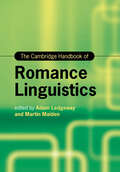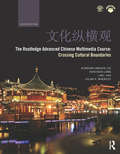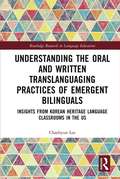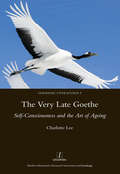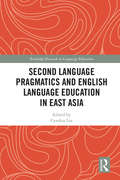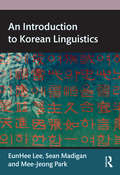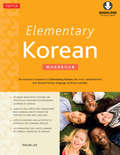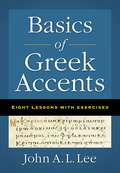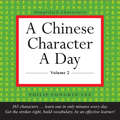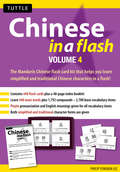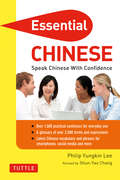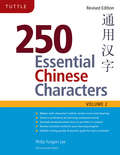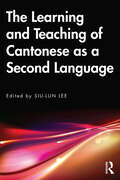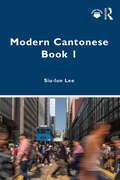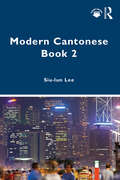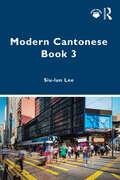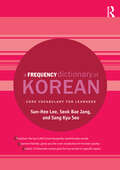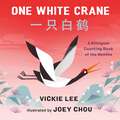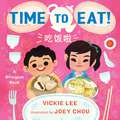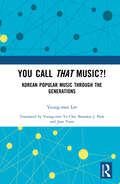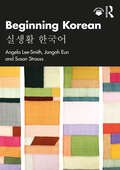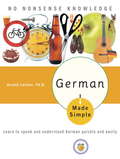- Table View
- List View
The Cambridge Handbook of Romance Linguistics (Cambridge Handbooks in Language and Linguistics)
by Adam Ledgeway Martin MaidenThe Romance languages and dialects constitute a treasure trove of linguistic data of profound interest and significance. Data from the Romance languages have contributed extensively to our current empirical and theoretical understanding of phonetics, phonology, morphology, syntax, semantics, pragmatics, sociolinguistics, and historical linguistics. Written by a team of world-renowned scholars, this Handbook explores what we can learn about linguistics from the study of Romance languages, and how the body of comparative and historical data taken from them can be applied to linguistic study. It also offers insights into the diatopic and diachronic variation exhibited by the Romance family of languages, of a kind unparalleled for any other Western languages. By asking what Romance languages can do for linguistics, this Handbook is essential reading for all linguists interested in the insights that a knowledge of the Romance evidence can provide for general issues in linguistic theory.
The Routledge Advanced Chinese Multimedia Course: Crossing Cultural Boundaries
by Carolyn Lee Hsin-Hsin Liang Liwei Jiao Julian WheatleyThe Routledge Advanced Chinese Multimedia Course: Crossing Cultural Boundaries is an innovative multimedia course for advanced students of Chinese. Written by a team of highly experienced instructors, the book offers advanced learners the opportunity to consolidate their knowledge of Chinese through a wide range of activities designed to build up both excellent language skills and cultural literacy.? Divided into four thematic units covering popular culture, social change, cultural traditions, and politics and history, with each unit presenting three individual lessons, the volume provides students with a structured course which efficiently supports the transition from an intermediate to an advanced level. The many different texts featured throughout the lessons present interesting and accurate information about contemporary China and introduce students to useful vocabulary, speech patterns, and idiosyncratic language usage. Key features include Lively and detailed discussions of grammatical points and sentence patterns Engaging exercises for developing grammatical concepts and insight into the character writing system Systematic review of earlier material to ensure consolidation of learning Coverage of diverse and culturally relevant topics such as online dating, changing views of marriage, food culture, Confucianism? and democracy in China. Extensive cultural and historical notes providing background to the subjects presented Complementary CDs to enhance listening skills. Free companion website (http://duke.edu/web/chinesesoc/) offering a wealth of video content forming the basis of many of the listening activities linked to topics within the book. Extensively revised and updated throughout, this new edition includes new material and activities on synonyms and substantial improvements to the "composition", "Focus on characters" and "Language practicum" sections. The improved Instructor’s Resource Manual, which includes activity tips, additional exercises, answer keys and the traditional character texts, is available at http://www.routledge.com/books/details/9780415841337/
Understanding the Oral and Written Translanguaging Practices of Emergent Bilinguals: Insights from Korean Heritage Language Classrooms in the US (Routledge Research in Language Education)
by Chaehyun LeeDetailing qualitative research undertaken with elementary-grade children in a Korean heritage language school in the US, this text provides unique insight into the translanguaging practices and preferences of young, emergent bilinguals in a minority language group. Understanding the Oral and Written Translanguaging Practices of Emergent Bilinguals examines the role of socio-cultural influences on emergent bilinguals’ language use and development. Particular attention is paid to the role of immigrant parental involvement and engagement in their bilingual children’s language learning and academic performance. Presenting data from classroom audio recordings, writing, and drawing samples, as well as semi-structured interviews with children and parents, the book identifies important implications for the education of emergent bilinguals to better support their overall language and literacy development. This text will primarily be of interest to doctoral students, researchers, and scholars with an interest in bilingual education, biliteracy, and early literacy development more broadly. Those interested in applied linguistics, the Korean language, and multicultural education will also benefit from this volume.
The Very Late Goethe: Self-Consciousness and the Art of Ageing
by Charlotte LeeGoethe's career was an unusually long and productive one: he became a literary celebrity in the 1770s and remained so until his death in 1832. The distinguishing feature of his last works is their self-consciousness, their preoccupation both with the business of writing and with personal development. In the first cross-genre study of this period of Goethe's work, Charlotte Lee traces the theme in his last major poems and autobiographical writings, before turning to the two 'giants', 'Wilhelm Meisters Wanderjahre' and 'Faust II'. All these works share a tendency to allude subtly to earlier moments from Goethe's own literary output, but to fashion them into writing which is quite new - even though (or perhaps because) he himself is old. This book seeks to understand the unique perspective of one nearing the end of a long life.
Second Language Pragmatics and English Language Education in East Asia (Routledge Research in Language Education)
by Cynthia LeeThis edited collection addresses the link between second language pragmatics (including interlanguage and intercultural) research and English language education. The chapters use different contemporary research methods and theoretical frameworks such as conversation analysis, language-learners-as-ethnographers, discourse and interactional approaches and data in contexts (either in the region or overseas). The content explores and discusses the significance of learning and teaching of second language (L2) pragmatics in language education for learners who use English as a lingua franca for academic and intercultural communication purposes with native and non-native speakers of English, focusing on pragmatic actions, social behaviours, perceptions and awareness levels in three regions in East Asia – China, Japan and South Korea. It is an important contribution to the area of second language pragmatics in language education for East Asian learners. It recommends research-informed pedagogies for the learning and teaching of interlanguage or intercultural pragmatics in regions and places where similar cultural beliefs or practices are found. This is an essential read for researchers, language educators, classroom teachers, readers who are interested in second language pragmatics research and those interested in second language acquisition and English language education in the East Asian context.
An Introduction to Korean Linguistics
by Eunhee Lee Sean Madigan Mee-Jeong ParkAn Introduction to Korean Linguistics is a valuable and comprehensive text for those with an interest in Korean linguistics. This book provides an in-depth introduction to the basics of Korean linguistics, and modern linguistic theory, in an accessible style. It features a step-by-step approach designed to lead the reader through the linguistic make-up of the language, from the basics of its sound system and sentence structure to the semantics of modern spoken Korean. Features include: Detailed chapters covering the core areas in the field of linguistics, including phonetics, phonology, morphology and syntax Clear and accessible explanations which effectively demonstrate the intricacies and subtleties of the Korean language Suggested readings for those interested in expanding their knowledge of a specific topic Exercises designed to complement the factual and analytical issues covered in each chapter A comprehensive glossary of central terms and a companion website offering a wealth of additional materials. Korean is an invaluable language for the study of theoretical and comparative linguistics as it provides important examples and counter-examples to key issues, making An Introduction to Korean Linguistics an essential text for students and professional linguists alike.
Elementary Korean Workbook
by Insun LeeThis is a extensive beginning level Korean workbook.This helpful practice book is intended as a companion to Elementary Korean but can be used with any other Korean textbook or as a stand alone self-study guide to learn Korean. Elementary Korean Workbook is essential for practicing and polishing your proficiency in everyday conversational beginner Korean. Here are carefully crafted activities for expanding your abilities to read Korean, write Korean, comprehend Korean, and speak Korean. The MP3 audio CD helps build listening comprehension and ensure correct pronunciationThe variety of activities offers beginning learners the range of practice opportunities they need: Korean language dialogues. Translation exercises from Korean into English, and visa versa. Comprehension, vocabulary, and grammar exercises. Reading practice passages. Language keys for all activities. Accompanying audio CD.
Elementary Korean Workbook: (downloadable Audio Included)
by Insun LeeThis is a extensive beginning level Korean workbook. This helpful practice book is intended as a companion to Elementary Korean but can be used with any other Korean textbook or as a stand alone self-study guide to learn Korean. Elementary Korean Workbook is essential for practicing and polishing your proficiency in everyday conversational beginner Korean. Here are carefully crafted activities for expanding your abilities to read Korean, write Korean, comprehend Korean, and speak Korean. The MP3 audio CD helps build listening comprehension and ensure correct pronunciation The variety of activities offers beginning learners the range of practice opportunities they need: Korean language dialogues. Translation exercises from Korean into English, and visa versa. Comprehension, vocabulary, and grammar exercises. Reading practice passages. Language keys for all activities. Accompanying audio CD.
Basics of Greek Accents: Eight Lessons with Exercises
by John A. LeeBasics of Greek Accents by John A. L. Lee is a compact, student-friendly, and practical guide to accents for students of both classical and biblical Greek. In eight simple lessons students will learn the basics of ancient Greek accentuation.Ideal for beginners who are just learning the language or for intermediate students who have learned some Greek but are unsure of their accents this handy resource avoids theory and concentrates on taking the learner through the essentials in a natural sequence and reinforces learning by means of simple exercises.
A Chinese Character a Day Practice Pad Volume 2
by Philip Yungkin LeeThis calendar-like practice pad allows you to effectively practice Chinese characters and learn a year's wroth of characters in just minutes a day.Although more people are studying the Chinese language than ever before, others are still wary of starting because they believe, "it's too difficult." But A Chinese Character A Day, Volume 2 will show beginner-intermediate students that learning Mandarin Chinese characters is highly manageable when absorbed in small doses. It will help intermediate and advanced Chinese learners review and improve upon their past studies and practice written Chinese every day. Chinese characters (hanzi) are fascinating pictographic symbols that each have a specific meaning. After a few weeks of gradual progress your ability to read Chinese, write Chinese and pronounce Chinese will grow tremendously.This calendar like desk companion starts with the most basic Chinese characters and builds upon itself, one day at a time. For easy reference and review, a booklet listing the 365 Chinese characters is included. Each of the 365 pages contain these six components:The featured Chinese character. The English meaning. The pronunciation written in romanized Chinese (hanyu pinyin). Related compounds with their meanings and pronunciations. Stroke-order diagrams. 28 practice squares.To get started with A Chinese Character a Day, turn to Day One and begin by studying the character, its readings, meanings and sample compounds. Then tear off the sheet and, using the stroke-order guide, practice writing the character in the spaces provided. In a matter of days you'll be on your way to reading and writing Chinese with ease!
A Chinese Character a Day Practice Pad Volume 2
by Philip Yungkin LeeThis calendar-like practice pad allows you to effectively practice Chinese characters and learn a year's wroth of characters in just minutes a day.Although more people are studying the Chinese language than ever before, others are still wary of starting because they believe, "it's too difficult." But A Chinese Character A Day, Volume 2 will show beginner-intermediate students that learning Mandarin Chinese characters is highly manageable when absorbed in small doses. It will help intermediate and advanced Chinese learners review and improve upon their past studies and practice written Chinese every day. Chinese characters (hanzi) are fascinating pictographic symbols that each have a specific meaning. After a few weeks of gradual progress your ability to read Chinese, write Chinese and pronounce Chinese will grow tremendously.This calendar like desk companion starts with the most basic Chinese characters and builds upon itself, one day at a time. For easy reference and review, a booklet listing the 365 Chinese characters is included. Each of the 365 pages contain these six components:The featured Chinese character. The English meaning. The pronunciation written in romanized Chinese (hanyu pinyin). Related compounds with their meanings and pronunciations. Stroke-order diagrams. 28 practice squares.To get started with A Chinese Character a Day, turn to Day One and begin by studying the character, its readings, meanings and sample compounds. Then tear off the sheet and, using the stroke-order guide, practice writing the character in the spaces provided. In a matter of days you'll be on your way to reading and writing Chinese with ease!
A Chinese Character A Day Volume 2
by Philip Yungkin LeeThis calendar-like practice pad allows you to effectively practice Chinese characters and learn a year's wroth of characters in just minutes a day. Although more people are studying the Chinese language than ever before, others are still wary of starting because they believe, "it's too difficult. " But A Chinese Character A Day, Volume 2 will show beginner-intermediate students that learning Mandarin Chinese characters is highly manageable when absorbed in small doses. It will help intermediate and advanced Chinese learners review and improve upon their past studies and practice written Chinese every day. Chinese characters (hanzi) are fascinating pictographic symbols that each have a specific meaning. After a few weeks of gradual progress your ability to read Chinese, write Chinese and pronounce Chinese will grow tremendously. This calendar like desk companion starts with the most basic Chinese characters and builds upon itself, one day at a time. For easy reference and review, a booklet listing the 365 Chinese characters is included. Each of the 365 pages contain these six components: The featured Chinese character. The English meaning. The pronunciation written in romanized Chinese (hanyu pinyin). Related compounds with their meanings and pronunciations. Stroke-order diagrams. 28 practice squares. To get started with A Chinese Character a Day, turn to Day One and begin by studying the character, its readings, meanings and sample compounds. Then tear off the sheet and, using the stroke-order guide, practice writing the character in the spaces provided. In a matter of days you'll be on your way to reading and writing Chinese with ease!
Chinese in a Flash Volume 4
by Philip Yungkin LeeChinese in a Flash Volume 4 continues to provide more resources for Chinese language students wishing to learn Chinese quickly and easily. This unique set of Chinese flash cards enables learners to acquire more Chinese words and their derivatives in an easy-to-use manner, at a pace to be set by the learners themselves. Common idiomatic expressions are widely distributed among the cards; learners who master these will come to appreciate the beauty of the Chinese language by using a few words to say a thousand different things.
Essential Chinese
by Philip Yungkin Lee Shun-Yao ChangA concise Mandarin Chinese phrase book and guide to Chinese language, Essential Chinese contains basic vocabulary necessary for communicating in Mandarin Chinese.Mandarin Chinese actually has simpler grammar than English and there are no conjugations-meaning anyone can learn a few important phrases in no time.Essential Chinese is a great first introduction and beginner guide to the language of China and Taiwan. Perfect for business people or tourist traveling to China or for students who want to supplement their learning (and get an A in Mandarin class!), this book's easy indexing feature allows it to act as an Chinese phrasebook or as a Mandarin to English Dictionary / English to Mandarin Dictionary. A clever "point to" feature allows you to simply point to a phrase translated in Chinese without the need to say a single word or read a single character. You will soon find yourself turning to Essential Chinese again and again when visiting and working or interacting with Chinese speakersIn this book you will find:Over 1500 practical sentences for everyday useA glossary of over 200 terms and expressionsTerms and phrases covering essential aspects of traveling and living in China
250 Essential Chinese Characters Volume 2
by Philip Yungkin Lee Darell TibblesMore than a simple update, 250 Essential Chinese Characters Volume 2 offers 250 more characters in the extremely useful learning format that learners and teachers alike continue to praise.Following in the footsteps of the newly released Volume 1, it includes everything that today's learners and teachers want: tips for mastery throughout; special exercises in AP-exam format; progressive review sections; and several indexes.
The Learning and Teaching of Cantonese as a Second Language
by Siu-Lun LeeThe Learning and Teaching of Cantonese as a Second Language brings together contributions on such issues as Cantonese textbooks, linguistic description, literacy and tone acquisition, supplemented by case studies from the Netherlands and Japan. The learning and teaching of Cantonese as a second language is a subject of considerable interest in the international academic community, and the first international symposium on teaching Cantonese as a second language, held at the Chinese University of Hong Kong in October 2019, brought together leading researchers in this field. This conference provided the inspiration for the current volume, The Learning and Teaching of Cantonese as a Second Language. In the Hong Kong context, historically, the term ‘Cantonese’ refers to the language varieties of immigrants who came to the territory from various areas in Guangdong province, including Macau, Panyu, Taishan, Xinhui and Zhongshan. From the late nineteenth century onwards, their speech coalesced into the contemporary variety of Cantonese used in Hong Kong today. The term ‘Cantonese’ is also used to refer to the entire Yue subgroup of Chinese, which includes varieties of Cantonese spoken in southern China, Hong Kong, Macau, Malaysia, Singapore and among overseas Chinese in Australia, Europe and North America. In all, it is estimated that there are about 70 million Cantonese speakers in the world. This volume is of direct relevance to educators, language teachers, linguists and all those concerned with the learning of Cantonese as a second language.
Modern Cantonese Book 1: A textbook for global learners
by Siu-lun LeeThe first volume of Modern Cantonese aims to provide solid linguistic training to beginner Cantonese learners, highlighting cultural points with lively language scenarios. This book provides daily conversational scenarios, such as introducing yourself and others, ordering food, going out with friends, shopping, planning a weekend, and talking about hobbies and leisure activities, as well as holidays and festivals. The scenarios cover daily settings with essential learning points, and on completion of the course, learners will be able to understand questions and statements in Cantonese conversations and will be able to discuss familiar everyday topics using simple sentences in Cantonese. The book is ideal for students seeking to learn Cantonese as a second language at the novice level, based on ACTFL speaking proficiency guidelines. It may also be of interest to language teachers and linguists in the field of Cantonese as a second language.
Modern Cantonese Book 2: A textbook for global learners
by Siu-lun LeeThe second volume of Modern Cantonese aims to facilitate learners in understanding the main ideas expressed in conversations and discussions, as well as exchanging information. This book is structured around situational scenarios, which cover informal and semi-formal settings in daily activities and work-related situations. After completing this volume, learners will be able to understand conversations and discussions relating to a range of activities in Hong Kong, Macau, and Shenzhen. This book is targeted at intermediate learners of Cantonese, while language teachers and linguists interested in Cantonese as a second language may also find it informative.
Modern Cantonese Book 3: A textbook for global learners
by Siu-lun LeeThe third volume of Modern Cantonese aims to broaden learners’ Cantonese language skills by teaching students how to deal with, discuss, persuade, and summarize topics related to sophisticated work-related situations. This book provides scenarios talking about abstract topics, as well as cultural and social issues in both formal and semi-formal settings. Learners gain the skills to discuss a variety of complex topics and abstract issues. This book is designed for intermediate to advanced learners who have reached Intermediate Mid (ACTFL) or B1 (CEFR) proficiency. Language teachers, linguists, and researchers interested in Cantonese as a second Language may also find the book informative.
A Frequency Dictionary of Korean: Core Vocabulary for Learners (Routledge Frequency Dictionaries)
by Sun-Hee Lee Seok Bae Jang Sang Kyu SeoA Frequency Dictionary of Korean is an invaluable tool for all learners of Korean, providing a list of the 5000 most frequently used words in the language. Based on the Sejong National Corpora, the largest written and spoken corpora in Korean comprised of 10 million words collected from different genres, the Dictionary provides the user with detailed information for each of the entries, including illustrative examples and English translations. The Dictionary provides a rich resource for language teaching and curriculum design, while a separate CD version provides the full text in a tab-delimited format ideally suited for use by corpus and computational linguists. With entries arranged both by frequency and alphabetically, A Frequency Dictionary of Korean enables students of all levels to get the most out of their study of vocabulary in an engaging and efficient way.
One White Crane: A Bilingual Counting Book of the Months
by Vickie LeeOne white crane, two black bears . . .Simply told and beautifully rendered, this counting board book takes young readers through the months of the year. Each month focuses on a new animal, from seals in May to cicadas in September. Sweet, accessible text in English and Chinese pairs with eye-catching art for a wonderful repeat reading experience.
Time to Eat!
by Vickie LeeSparse text and bright illustrations help readers learn the names of all of their favorite dishes in both English and Mandarin. From spare ribs to spring pea shoots there's something for everyone in this timeless story about dinner time.
You Call That Music?!: Korean Popular Music Through the Generations
by Young-mee LeeYou Call That Music?!: Korean Popular Music Through the Generations provides a critical overview of the history of Korean popular music from 1920 to the 2000s from the perspective of cultural history. First published in Korean in 2017 by one of the best-known critics, Lee Young-Mee, this book is a timely and much-needed source of information on Korean popular music of the past hundred years. Through this English translation, readers are able to make meaningful connections between specific forms of Korean popular music of various periods and the contemporaneous Korean social and political circumstances. Structured around the central theme of generational conflict, the book provides readers with an accessible way to engage with Korea’s social history and a greater understanding of how specific musical works, genres and styles fit into that history. Its strong narrative force helps illuminate the connections between modern Korean social history and the particular trends of musical production and their reception through the decades. You Call That Music?! is an invaluable resource for those researching and studying Korean popular music specifically as well as Korea’s cultural and social history.
Beginning Korean: 실생활 한국어
by Angela Lee-Smith Jongoh Eun Susan StraussBeginning Korean is a Korean language textbook for use at the high school and college levels, involving characters who speak and interact in Korean using beginner-to-intermediate-level expressions, vocabulary, and grammar.The book contains a rich variety of natural-sounding dialogues involving characters from a diverse range of backgrounds as they exchange ideas, make plans, and socialize in a variety of natural contexts in Korea. The book provides a wide variety of conversational expressions, grammar notes, and vocabulary items, in addition to ‘Cultural Insights’ to expand users’ understandings of and familiarity with Korean culture from more insider perspectives.Further supporting material, including audio, can be found at www.routledge.com/9781032687032. The book is designed around ACTFL’s 5 Cs (Communication, Cultures, Connections, Comparisons, and Communities) and includes specific proficiency-based Can-Do learning goals for each unit. As such, the content, topics, and areas of focus in this book can be useful for a wide range of programs, educators, and learners of Korean.
German Made Simple: Learn to speak and understand German quickly and easily (Made Simple)
by Arnold LeitnerLearning German Has Never Been Easier! Whether you are studying the language in school, planning a trip to Germany or Austria, or trying to learn the basics of the language closest to English, German Made Simple is the perfect book for any self-learner. Void of all nonessentials and refreshingly easy to understand, German Made Simple includes:• Basics of German grammar• Modern German vocabulary• German pronunciation guide• German reading exercises• German economic information• Common German expressions• Review exercises• Complete answer key• German-English dictionary
